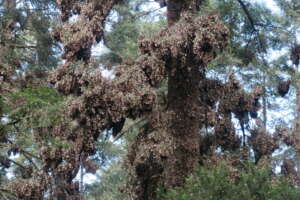High-altitude forest health assessment
Using drone flight over the Federal Government property inside the Core Zone of the MBBR, Dr. Cuauhtémoc Sáenz-Romero's team documented forest health at this high-altitude site fully dominated by oyamels (Abies religiosa). The flight was conducted by José Luis Gallardo-Salazar, PhD student under the supervision of Dr. Sáenz-Romero and was funded by MBF & FOCEN (Conservation of the Neovolcanic Axis Fund).
Using a combination of visual (RGB-Red, Green, Blue) and multispectral cameras, José Luis estimated the vigor of the trees and an Normalized Difference Vegetation Index (NDVI) for each tree. The diagnostic helped identify the percentage of standing dead trees (2 %), extremely stressed trees (brownish foliage, 5 %), apparently stressed trees (green-yellowish foliage, 44 %) and healthy trees (49 %). Although ground truthing to validate the imagery interpretation is still needed, the number of stressed trees is alarming. This is especially concerning since the flight was done at the end of the rainy season (October) in 2022.
Tree survival rates at different high-altitude locations
Working at the Nevado de Toluca, State of Mexico, an area close to the MBBR, Dr. Saénz's team also evaluated tree survival rates at different altitudes above the current boundary of 3500m. Survival was found to be favorable at 3800 m (70%), but less so at 4000 m (45%), indicating that shifting the natural current upper altitudinal limit to 3800m (a 300 m increase) is feasible, while going up to 4000m (a 500m increase) leads to increased mortality and negative growth rates.
Nurse plant experiments
Nurse plant experiments conducted in Sierra Chincua at
disturbed sites showed that two years after planting, survival
rates for Broom (Baccharis conferta) and Snakeroot (Eupatorium
glabratum) were 50% and 43% respectively. Considering the challenging
environmental conditions of disturbed sites, these survival rates are
encouraging. Projections for growth indicate that Broom may reach a
height of 1 meter (considered suitable to serve as a nurse plant) within
5 years of planting, exceeding initial expectations of lengthy waiting
time for healthy shrub coverage.
Dr. Sáenz and his colleagues are also continuing their nurse plant experiment trainings with communities who are collaborating with them as shown in the video below.
These experiments are helping us understand and plan for future climate conditions so that monarchs will continue to have healthy overwintering forests in the future! MBF is pleased to support this necessary research to improve conservation efforts in the face of climate change.
Dr. Cuauhtémoc Sáenz-Romero's assisted migration experiments are featured in a new PBS series, Dynamic Planet.
The series explores climate change impacts worldwide and introduces the viewer to scientists and indigenous communities working to develop innovative solutions. Dr. Sáenz-Romero's work at the MBBR and Nevado de Toluca is featured in episode 4, beginning at minute 33:40 and minute 39:34.
See more on https://www.pbs.org/show/dynamic-pl net/.






